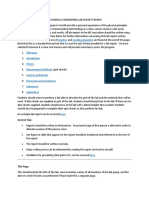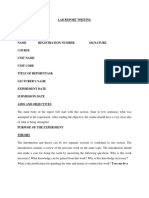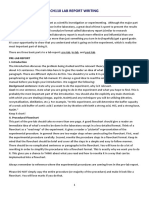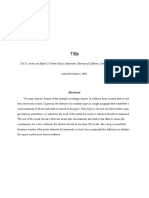Formallabreport 100
Formallabreport 100
Uploaded by
api-242706427Copyright:
Available Formats
Formallabreport 100
Formallabreport 100
Uploaded by
api-242706427Original Title
Copyright
Available Formats
Share this document
Did you find this document useful?
Is this content inappropriate?
Copyright:
Available Formats
Formallabreport 100
Formallabreport 100
Uploaded by
api-242706427Copyright:
Available Formats
WRITING FORMAL LAB REPORTS You have to understand the material in order to write a good lab report.
For this course, I would like you to seriously regard the lab reports as a means of learning about the subject. If you do not understand the lab, or how the report should be written, you will be unable to write a good report! Your lab report should be divided into sections with headings. This makes it easier for the reader to find information quickly. The five sections are: Introduction (including experimental aim), Procedures (sometimes called "Methods"), Results, Discussion and Conclusion. If you have used information from a source other than yourself, you must cite the reference. Add a section of References to the end of your report! To do otherwise is PLAGIARISM, which is a very serious offense. In the professional world it can cost you your career or reputation. In college it can cause you to fail a course or even be dismissed from school. Introduction and Experimental Hypothesis: This section should contain the following: 1. Background information consisting of a brief overview of the concepts behind the lab, 2. A statement of what general technique(s) were used and, 3. A statement of the purpose(s) or hypothesis of the lab. This should be written as a formal statement in the form of an if.then statement. Your hypothesis statement should include the relationship between the dependent and independent variable in the experiment. Do not rely exclusively on the lab handouts for the background; use, at least, your textbook as another source. But be careful in using your sources. Read your source material well enough to clearly understand it. Then put this down in your own words. Think what you did during the lab exercise and decide what the major purpose of the exercise was. Then put this down in your own words. Procedure (or Materials/Method): You should include the equipment used and any solutions (identity and concentration) used in the experiment. You should write your method in the past tense explaining what you actually did. The method should be presented as a list of numbered steps taken to complete the experiment. You should define the dependant and independent variables as well as any controls used in your experiment in this section. This report should be written so that a person with a basic knowledge of the subject could follow your method and repeat your experiment. You should NOT include results here! Results: A graph(s) or table(s) of the data should be used to allow the reader to easily see the data. Any table or figure used to present the results MUST have an explicit title, table/figure number and a legend below the figure or table briefly describing what data is presented in the figure. The figure and table numbers allow you to refer the reader to the correct figure when explaining your results in the discussion section of your report. All columns (or axis on graphs) must indicate what is measured and the units of measurement.
Discussion: In this section you should relate the results to the "big picture" and the points you raised in your introduction. You must explain to the reader your data or results in your own words explaining the relationship between the variables you measured and the patterns and trends (or lack or trends) in your findings. Explain how major findings support or refute your hypothesis. You should always indicate which table or figure you are referring to when discussing each section of your results (as mentioned above). Review your results part by part, making comments as to whether you expected that result or not. You might want to make comments about what you might have changed or done differently and any applicable methods you know that could have been done in follow-up experiments to support your findings. Finally, you may want to make comments about what you might have changed or done differently. What are the possible sources of error in your experiment? Conclusion: This should be a couple of sentences summarizing whether your findings support or refute your hypothesis. Was your experiment successful? References: You must cite all sources used at the end of your laboratory report. All references should be listed correctly using APA format. Read the section in course information on how to cite references correctly using APA format from the college library. Some Writing Tips: When you are finished writing re-read it, asking yourself if each sentence makes sense. Does one sentence make a logical connection to the previous one? For most of us writing takes work; changing, deleting, adding, rearranging. In fact writing may be the most important skill you develop while in college. After all it is through writing that so much information is communicated, especially in the Forensics lab where unclear writing, misinterpretation or mistakes could be the difference between conviction or exoneration of a suspect!
L. Fowler. Ph.D. (1/06)
You might also like
- Physics 1 and Physic 2 SPH 2170 and 2171Document35 pagesPhysics 1 and Physic 2 SPH 2170 and 2171patrickNo ratings yet
- How To Write A Psychology Lab ReportDocument2 pagesHow To Write A Psychology Lab ReportAmirrul IdhamNo ratings yet
- Michael Sba OADocument20 pagesMichael Sba OALisa B Arnold100% (7)
- Lab Report Directions PDFDocument6 pagesLab Report Directions PDFRacheal ShaktiNo ratings yet
- AP Lab Report Format 14Document4 pagesAP Lab Report Format 14Erly FabriagaNo ratings yet
- Mechanical Engineering Lab Report FormatDocument5 pagesMechanical Engineering Lab Report FormatPhilipNo ratings yet
- Physics 1 and Physic 2 SPH 2170 and 2171Document31 pagesPhysics 1 and Physic 2 SPH 2170 and 2171ayonga ochako erickNo ratings yet
- Writing Across The Curriculum Lab ReportDocument4 pagesWriting Across The Curriculum Lab Reportapi-399890657No ratings yet
- Writing A Formal Laboratory ReportDocument2 pagesWriting A Formal Laboratory ReportAsh ZikryNo ratings yet
- Analytical Chemistry Lab Manual: Spring 2018Document12 pagesAnalytical Chemistry Lab Manual: Spring 2018Asep Iwan PurnawanNo ratings yet
- Chemistry: Overview Guidelines Samples Lab ReportsDocument4 pagesChemistry: Overview Guidelines Samples Lab ReportsleunammeNo ratings yet
- MCB 3020L Lab Report Guidelines-1Document5 pagesMCB 3020L Lab Report Guidelines-1AWEDNo ratings yet
- Biology Lab ReportDocument4 pagesBiology Lab ReportNerdyMiggitNo ratings yet
- Final Chemistry Lab Report Resource 2Document6 pagesFinal Chemistry Lab Report Resource 2Eddieson ParadoNo ratings yet
- Writing STS ReportDocument5 pagesWriting STS ReportRavishankarNo ratings yet
- AP Bio Lab Report Format GuidesDocument7 pagesAP Bio Lab Report Format GuidesPatriciaNo ratings yet
- Brief Lab Report GuidelinesDocument3 pagesBrief Lab Report Guidelinesblurt23No ratings yet
- BIOL-116 Lab Report InstructionsDocument4 pagesBIOL-116 Lab Report InstructionsowenwainsworthNo ratings yet
- How To Write A Lab ReportDocument17 pagesHow To Write A Lab ReportDeimante BlikertaiteNo ratings yet
- Writing STS ReportDocument4 pagesWriting STS ReportSairam CNo ratings yet
- Laboratory Report - Sample Format: Prepared by S.Praveenkumar/Assistant Professor/Department of Civil Engineering/PsgctDocument3 pagesLaboratory Report - Sample Format: Prepared by S.Praveenkumar/Assistant Professor/Department of Civil Engineering/PsgctS PraveenkumarNo ratings yet
- Laboratory Report Format: What and Why How What You Found What It MeansDocument4 pagesLaboratory Report Format: What and Why How What You Found What It MeansSophia NuelleNo ratings yet
- ELECTRICITY AND MAGNETISM I SPH 2101 and 2105 - Industrial ChemDocument25 pagesELECTRICITY AND MAGNETISM I SPH 2101 and 2105 - Industrial ChemIAMMARKSNo ratings yet
- Bio Lab ManualDocument30 pagesBio Lab Manual6cpf9rr5d5No ratings yet
- Criteria For Writing A Formal Lab Report (Spring 2023) - 1Document5 pagesCriteria For Writing A Formal Lab Report (Spring 2023) - 1omar.abudiab64No ratings yet
- Writing STS ReportDocument4 pagesWriting STS ReportS ArtNo ratings yet
- Lab Report FormattingDocument4 pagesLab Report Formattingmonaxe.from.xboxNo ratings yet
- Writing An Academic ReportDocument2 pagesWriting An Academic ReportMehreenNo ratings yet
- What Is A Lab Report?: Introduction To Academic WritingDocument11 pagesWhat Is A Lab Report?: Introduction To Academic WritingJenny-Vi LogronioNo ratings yet
- Lab ReportsDocument2 pagesLab Reportseasymoneysniper100% (1)
- ASP - Session 9 Report Writing (Rev 2023 Jan)Document13 pagesASP - Session 9 Report Writing (Rev 2023 Jan)alamconfiNo ratings yet
- Writing A Lab ReportDocument4 pagesWriting A Lab ReportAzliyana Mat LazinNo ratings yet
- How To Write A Lab Report To Impress Your TA PDFDocument5 pagesHow To Write A Lab Report To Impress Your TA PDFTonya NormanNo ratings yet
- Guideline To Laboratory Report Writing PDFDocument2 pagesGuideline To Laboratory Report Writing PDFIjal JaminNo ratings yet
- HILL Template 2023.docx665e656f27e5753785Document4 pagesHILL Template 2023.docx665e656f27e5753785kennmuteti99No ratings yet
- PHYS LAB REPORT FORMATDocument7 pagesPHYS LAB REPORT FORMATchikotibartholomewpatrickNo ratings yet
- List of Mistakes and CommentsDocument12 pagesList of Mistakes and Commentsyaqoob MahNo ratings yet
- I. Thesis Structure: Title PageDocument14 pagesI. Thesis Structure: Title PageRaza HussainNo ratings yet
- Guidelines For Technical Report WritingDocument2 pagesGuidelines For Technical Report Writingvinessen mootoosamyNo ratings yet
- Lab Report WritingDocument6 pagesLab Report WritingkiokocurtisNo ratings yet
- Writing Sts ReportDocument5 pagesWriting Sts ReportBeing SikanderNo ratings yet
- Ahs Word-EceDocument14 pagesAhs Word-EcesubaNo ratings yet
- Grade 9-10 Formal Lab Report GuidelinesDocument4 pagesGrade 9-10 Formal Lab Report Guidelinesgoat543216No ratings yet
- Components of A Research PaperDocument6 pagesComponents of A Research PaperMark Alvin Jay CarpioNo ratings yet
- Photosynthesis Lab Report InstructionsDocument2 pagesPhotosynthesis Lab Report InstructionsjalahdixonNo ratings yet
- Ch110 Lab Report WritingDocument5 pagesCh110 Lab Report WritingLazy BanditNo ratings yet
- Sample Lab Assignment ReportDocument1 pageSample Lab Assignment ReportFarhad Hossain TamzidNo ratings yet
- Guide For Writing Laboratory Reports - 2021Document7 pagesGuide For Writing Laboratory Reports - 2021Hussain Ali MurtazaNo ratings yet
- Writing STS ReportDocument5 pagesWriting STS ReportManas GuptaNo ratings yet
- Title: You D. Author and Maybe U. Partner Physics Department, University of California, Santa Barbara, CA 93106Document5 pagesTitle: You D. Author and Maybe U. Partner Physics Department, University of California, Santa Barbara, CA 93106John LoppNo ratings yet
- 3 How To Write A Lab ReportDocument20 pages3 How To Write A Lab ReportMa Fatima Bacala100% (1)
- Thesis MetodDocument6 pagesThesis Metodaliabrar.112233No ratings yet
- How To Write A Practical GuideDocument4 pagesHow To Write A Practical GuideCiprian FodorNo ratings yet
- How To Write A Scientific Laboratory Report: Before You Begin Your Lab ReportDocument3 pagesHow To Write A Scientific Laboratory Report: Before You Begin Your Lab ReportJohn Paul PanganibanNo ratings yet
- Writing A Laboratory ReportDocument10 pagesWriting A Laboratory ReportDaniel Cosgrove100% (1)
- E.R.A FormatDocument2 pagesE.R.A FormatmishiemichelleNo ratings yet
- Reference Format Lab ReportDocument6 pagesReference Format Lab Reportsnnscprmd100% (1)
- Research & the Analysis of Research Hypotheses: Volume 2From EverandResearch & the Analysis of Research Hypotheses: Volume 2No ratings yet
- How to Write a Dissertation: An Instructional Manual for Dissertation Writers.From EverandHow to Write a Dissertation: An Instructional Manual for Dissertation Writers.No ratings yet
- AP English Language and Composition Exam: Guide for EssaysFrom EverandAP English Language and Composition Exam: Guide for EssaysRating: 1 out of 5 stars1/5 (3)
- Phenotypic Diversity Among The Virginia Breeding Lines of Groundnut (#1152984) - 2571852Document10 pagesPhenotypic Diversity Among The Virginia Breeding Lines of Groundnut (#1152984) - 2571852gangak3337No ratings yet
- Iiiii: by Lewis G. Harriman III, Member ASHRAE, and James Judge, P.E., Member ASHRAEDocument6 pagesIiiii: by Lewis G. Harriman III, Member ASHRAE, and James Judge, P.E., Member ASHRAERafael Echano AcederaNo ratings yet
- Succession Vdvillar FinalDocument11 pagesSuccession Vdvillar FinalSeanJethroNo ratings yet
- 3 CitizenshipDocument1 page3 CitizenshipJohn Andrae MangloNo ratings yet
- SS1 Q2 Tula Peer Evaluation Form - J11 - CuetoDocument2 pagesSS1 Q2 Tula Peer Evaluation Form - J11 - Cuetoonemariuscueto2011No ratings yet
- Derivation of The Normal Equation For Linear Regression - Eli Bendersky's WebsiteDocument2 pagesDerivation of The Normal Equation For Linear Regression - Eli Bendersky's Websitealanpicard2303No ratings yet
- 4.-Sinif-Ingilizce-Yillik-Plan-2021-2022-by-ingilizceciyiz.com_Document12 pages4.-Sinif-Ingilizce-Yillik-Plan-2021-2022-by-ingilizceciyiz.com_Etraflı ÖydenNo ratings yet
- PE Code of EthicsDocument2 pagesPE Code of EthicsRajdeep FadteNo ratings yet
- LTW4 Tests U03 StandardDocument4 pagesLTW4 Tests U03 StandardPatricia Iglesias Fernández100% (1)
- Operatoin Management SolvedDocument28 pagesOperatoin Management SolvedSantolashNo ratings yet
- Syllabus 2Document6 pagesSyllabus 2api-266707896No ratings yet
- BeggvDocument11 pagesBeggvapi-450497170No ratings yet
- Austin Journal of Clinical OphthalmologyDocument14 pagesAustin Journal of Clinical OphthalmologyAustin Publishing GroupNo ratings yet
- Murty-Phanikumar2010 Article MicrostructureEngineeringOfMat PDFDocument1 pageMurty-Phanikumar2010 Article MicrostructureEngineeringOfMat PDFnghiaNo ratings yet
- 1179A-Tiebreaking Evaluation Contest PDFDocument2 pages1179A-Tiebreaking Evaluation Contest PDFAnirudhNo ratings yet
- Seminarski Rad: Fakultet Za Pravo, Bezbednost I Menadžment ,,konstantin Veliki" BeogradDocument14 pagesSeminarski Rad: Fakultet Za Pravo, Bezbednost I Menadžment ,,konstantin Veliki" BeogradPavle PopovicNo ratings yet
- RT3200 Quality Assurance ManualDocument126 pagesRT3200 Quality Assurance ManualJorge FiserNo ratings yet
- Final Exam Front PageDocument6 pagesFinal Exam Front PageaminarizwanNo ratings yet
- v6.3.2b Releasenotes v1.0-1Document115 pagesv6.3.2b Releasenotes v1.0-1Thirunavukkarasu ThangavelNo ratings yet
- MusicDocument5 pagesMusicLeonardo Bruno JrNo ratings yet
- Information Summary Sheet JU Application Form No: For Post of Associate Professor/ ProfessorDocument9 pagesInformation Summary Sheet JU Application Form No: For Post of Associate Professor/ ProfessorputmyNo ratings yet
- DLL English W7 2QDocument5 pagesDLL English W7 2Qjanuary3196 :DNo ratings yet
- The Pre-History of Calculus in Medieval KeralaDocument14 pagesThe Pre-History of Calculus in Medieval Keralaapi-26401608No ratings yet
- Area Chart in WPFDocument12 pagesArea Chart in WPFAbhiNo ratings yet
- ITB Assignment 1Document8 pagesITB Assignment 1Sana MirNo ratings yet
- Hasil Eviews Dikurangi Variable Dan Ditambah TahunDocument4 pagesHasil Eviews Dikurangi Variable Dan Ditambah Tahun18044 Ai YulianiNo ratings yet
- Enhancing Effectiveness of Extension Strategies: The Case of Madrasah Sa Basak in Lanao Del Sur, PhilippinesDocument7 pagesEnhancing Effectiveness of Extension Strategies: The Case of Madrasah Sa Basak in Lanao Del Sur, PhilippinesOel AtnaugaNo ratings yet
- Uts Bahasa Inggris Kelas X Semester 1Document9 pagesUts Bahasa Inggris Kelas X Semester 1Dita WardhanyNo ratings yet
- Space Exploration TimelineDocument26 pagesSpace Exploration TimelineKristine BarredoNo ratings yet

























































































